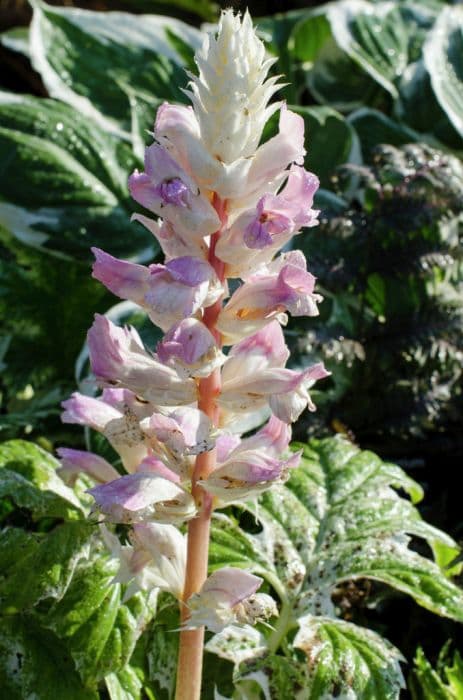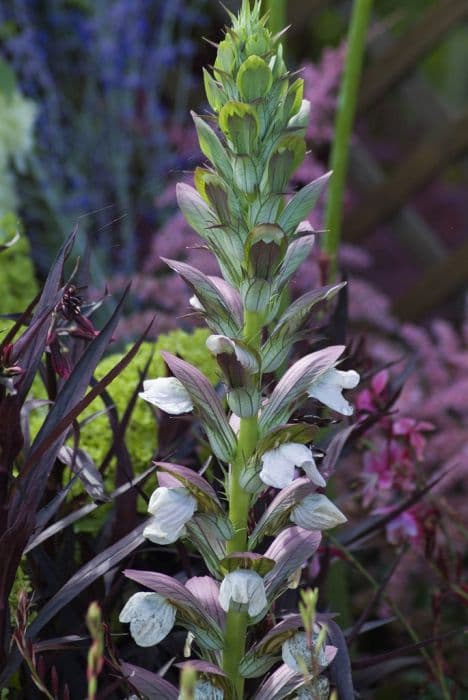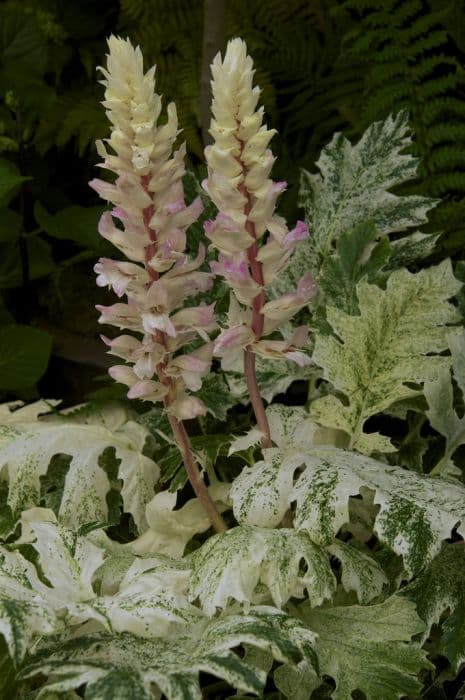Mysore Clock Vine Thunbergia mysorensis

ABOUT
Commonly known as the clock vine, this plant is admired for its striking floral display. It bears distinctive, long, pendulous racemes of flowers that are typically reddish-brown in color with a yellow throat, creating a bold contrast that is visually appealing. The individual flowers are tubular in shape and are arranged in a way that resembles a hanging chain, which is a characteristic feature of this species. The leaves of the clock vine are dark green, with a slightly leathery texture, and are arranged oppositely on the stem. They can vary in shape but often are heart-shaped at the base and taper to a pointed tip. This lush foliage provides a dense backdrop for the spectacular flowers and adds to the overall ornamental appeal of the plant. The vine itself is vigorous and has a twining growth habit, which allows it to climb up supports and structures, often used in gardens as a decorative feature on trellises, arbors, and fences. The combination of the attractive, twining foliage and the unique, hanging flower clusters makes the clock vine a popular choice among garden enthusiasts looking for a plant with both visual impact and an exotic touch.
About this plant
 Names
NamesFamily
Acanthaceae
Synonyms
Mysore Trumpetvine, Indian Clock Vine, Brick & Butter Vine, Dolls' Shoes, Lady's Slipper Vine
Common names
Hexacentris mysorensis.
 Toxicity
ToxicityTo humans
The Clock Vine is not widely known to be toxic to humans. However, there is limited information on the full extent of its toxicity, and it is not typically considered a food plant. As a general safety precaution, it is advisable not to ingest parts of ornamental plants. In case of accidental ingestion, if any symptoms such as gastrointestinal discomfort, skin irritation, or allergic reactions occur, seeking medical advice is recommended.
To pets
The Clock Vine is not specifically listed as toxic to pets such as dogs and cats. However, the same caution advised for humans applies to pets as well. Since there is limited information on its toxicity, it is best to prevent pets from ingesting parts of the plant. If a pet does consume any part of the Clock Vine and shows symptoms such as vomiting, diarrhea, or unusual behavior, it is important to contact a veterinarian.
 Characteristics
CharacteristicsLife cycle
Perennials
Foliage type
Evergreen
Color of leaves
Green
Flower color
Mixed
Height
6-8 feet (1.8-2.4 meters)
Spread
3-6 feet (0.9-1.8 meters)
Plant type
Climber
Hardiness zones
10
Native area
India
Benefits
 General Benefits
General Benefits- Aesthetic Appeal: The Mysore Trumpet Vine's cascading blossoms add vibrant color and tropical beauty to gardens.
- Attracts Wildlife: Its flowers provide nectar for hummingbirds and butterflies, encouraging biodiversity.
- Shade Provision: Can be grown to form a natural canopy, offering shaded areas in gardens or patios.
- Erosion Control: When used as a ground cover, it can help in preventing soil erosion.
- Privacy Screen: Its dense foliage can create living screens, enhancing privacy for outdoor living spaces.
- Versatility: Suitable for trellises, arbors, walls, and fences, offering various landscaping options.
- Fast Growth: Quick growing nature allows for rapid establishment and coverage in desired areas.
- Easy Propagation: Can be easily propagated from stem cuttings, making it cost-effective for gardeners.
 Medical Properties
Medical PropertiesThis plant is not used for medical purposes.
 Air-purifying Qualities
Air-purifying QualitiesThis plant is not specifically known for air purifying qualities.
 Other Uses
Other Uses- The Clock Vine's vibrant flowers are sometimes used in tropical-themed decorations or floral arrangements, adding exotic appeal to events and venues.
- In warm climates, Thunbergia mysorensis is used to cover and beautify unattractive structures like fences or walls, enhancing the aesthetic of gardens and outdoor spaces.
- As it attracts hummingbirds and butterflies, it is used to create wildlife-friendly gardens that support local ecosystems.
- The Clock Vine’s dense foliage can provide privacy screens in gardens and balconies when grown on trellises or pergolas.
- Some gardening enthusiasts use Thunbergia mysorensis in hanging baskets to feature its cascading flower trails in vertical gardening.
- The distinctive pattern and color of the flowers are sometimes a source of inspiration for artists and textile designers.
- In theme parks or botanical gardens, Thunbergia mysorensis is utilized to create living curtains or to embellish theme-oriented sections with its exotic look.
- The plant is used in educational environments, like schools and universities, to teach about plant biology, pollination, and horticulture due to its interesting structure and growth habits.
- Photographers and filmmakers might use Thunbergia mysorensis as a natural, colorful backdrop for photo shoots or film scenes, taking advantage of its aesthetic qualities.
- Landscape architects sometimes incorporate Thunbergia mysorensis into their designs for green buildings and sustainable architecture, creating a blend of functionality and beauty.
Interesting Facts
 Feng Shui
Feng ShuiThe Clock Vine is not used in Feng Shui practice.
 Zodiac Sign Compitability
Zodiac Sign CompitabilityThe Clock Vine is not used in astrology practice.
 Plant Symbolism
Plant Symbolism- Exotic Beauty: The Mysore Trumpet Vine, with its stunning yellow and red flowers, represents exotic beauty, captivating the senses and standing out amongst more common varieties.
- Creativity: With its unique cascading blossoms, this plant symbolizes creativity and inspires individuals to embrace their unique talents and ideas.
- Warmth and Invitation: The warm colors of the Mysore Trumpet Vine's flowers are reminiscent of a tropical climate, symbolizing warmth, hospitality, and inviting atmospheres.
- Vibrancy: The vivid colors and vigorous growth pattern of the vine stand for vibrancy in life, encouraging a lively and dynamic approach to living.
 Water
WaterThe Clock Vine should be watered thoroughly, allowing the top inch of the soil to dry out before the next watering. This typically means watering once a week, but frequency may need to increase during hot, dry spells, using about half a gallon for potted plants and up to 2 gallons for in-ground plants, depending on size. During the winter months, reduce watering to every other week. Always check the soil moisture level to avoid overwatering, which can lead to root rot.
 Light
LightThe Clock Vine thrives in bright, indirect light or dappled sunlight. It's best to place the vine where it will receive morning sunlight and protection from the intense afternoon sun, such as near an east-facing window or on a shaded porch.
 Temperature
TemperatureThe Clock Vine prefers warm temperatures between 60 to 85 degrees Fahrenheit and should not be exposed to temperatures below 50 degrees Fahrenheit as it is not frost-tolerant. Ideal growing conditions feature consistently warm temperatures without sudden fluctuations.
 Pruning
PruningTrim the Clock Vine after flowering to maintain its shape and encourage bushier growth. Pruning can be done once or twice a year, typically in the spring or summer. Remove any dead or damaged vines to promote the health and appearance of the plant.
 Cleaning
CleaningAs needed
 Soil
SoilThe best soil mix for the Mysore trumpet vine should be rich in organic matter, well-draining, and loamy. A mix of two parts peat or coco coir, one part perlite, and one part compost would be ideal. The soil pH should be slightly acidic to neutral, ranging between 6.0 and 7.5 to support optimal growth.
 Repotting
RepottingMysore trumpet vine should be repotted every 2-3 years to replenish nutrients and prevent rootbound conditions. Also, repotting should be done in spring or early summer when the plant is actively growing.
 Humidity & Misting
Humidity & MistingThe Mysore trumpet vine thrives in moderate to high humidity levels, ideally around 50-70%. If indoor air is dry, a room humidifier or a regular misting routine can help maintain the necessary humidity.
 Suitable locations
Suitable locationsIndoor
Place in bright indirect light, ensure high humidity, and support climbing.
Outdoor
Provide full sun to partial shade, protect from frost, and offer support.
Hardiness zone
10-11 USDA
 Life cycle
Life cycleThunbergia mysorensis, commonly known as the Mysore trumpet vine or Indian clock vine, begins its life cycle when a seed germinates, typically in warm, moist soil. The seedling emerges and develops into a juvenile plant with a main stem and few leaves. As it matures, it becomes a vigorously growing vine, producing extensive foliage and developing a robust root system. Optimal growth occurs in warm conditions with plenty of sunlight and well-drained soil. In its flowering stage, the vine produces distinctive, long pendulous racemes of yellow and reddish-brown flowers, which are pollinated by birds and insects, leading to the production of seeds. The cycle is completed when the vine's seeds are dispersed, often by animals or gravity, and germinate to produce a new generation of plants.
 Propogation
PropogationPropogation time
Spring to Summer
The most popular method of propagation for the Clock Vine, commonly known as Thunbergia mysorensis, is through semi-hardwood cuttings. This is usually done during the warmer months when the plant is actively growing, typically from late spring to early summer. To propagate, a cutting about 4 to 6 inches (10 to 15 centimeters) long is taken with several leaf nodes present. The lower leaves are removed and the cut end is then dipped in rooting hormone powder to encourage root growth. This cutting is then planted in a well-draining soil mix and kept in a warm place with indirect sunlight. It is essential to maintain humidity, often by covering the cutting with a plastic bag or placing it in a propagator. With proper care, roots will develop within a few weeks.
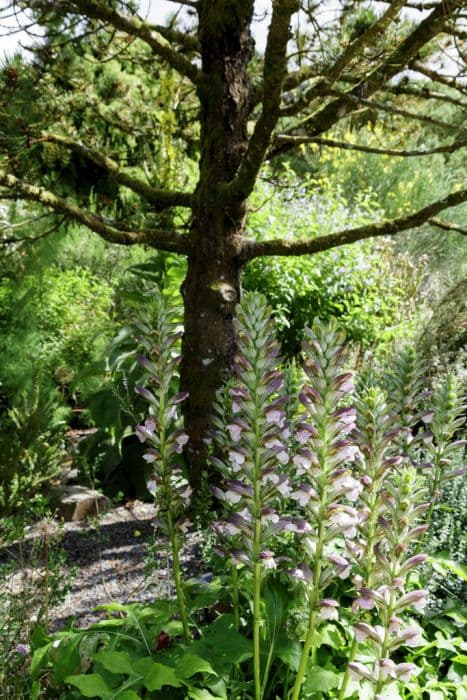
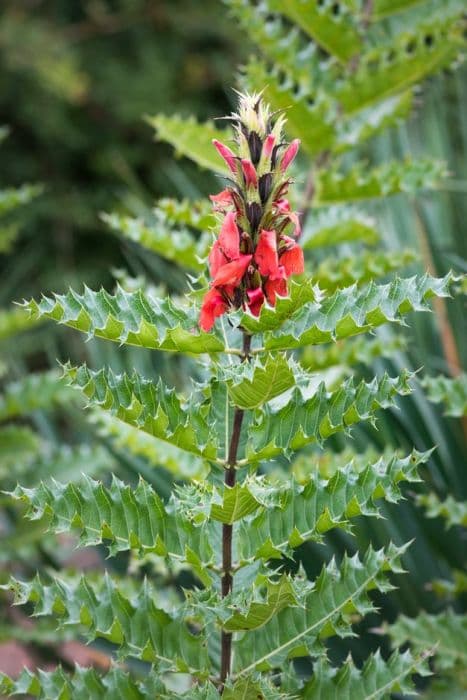
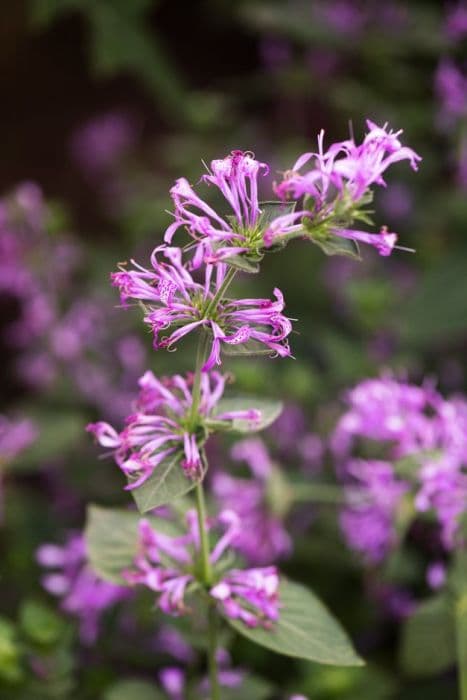
![Black-eyed Susan [Sunny Suzy Red-Orange]](/_next/image?url=https%3A%2F%2Fplants-admin.emdemapps.com%2Fimages%2Fplants%2F%2Fimages%2F607ea5891ee3f.jpg&w=640&q=75)
